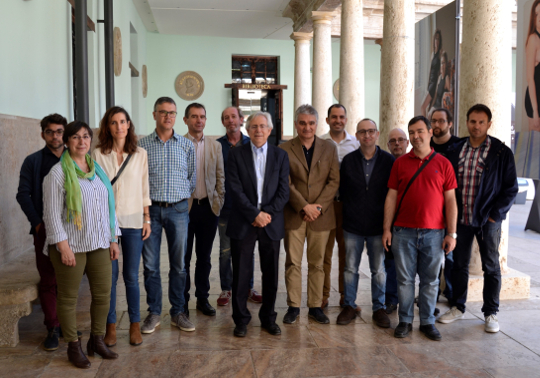
On Friday 17 May, the Universitat de València presented its own platform that will show online its heritage collections on the eve of International Museum Day, which will be held tomorrow, Saturday 18 May.
The presentation took place at the Cultural Centre La Nau and was attended by Antonio Ariño, Office of the Vice-Principal for Culture and Sport; Josep Vidal, head of the Information Systems Department at the Universitat de València; Adrià Besó, curator of Cultural Heritage at the Universitat de València and David Sánchez, technician in the Cultural Heritage Department at the Universitat de València. The aim of the Universitat is to bring together all its collections of cultural and scientific heritage in a single portal to make them accessible to society.
"In this initial phase, four large collections are presented: vascular plants, birds, electronic devices from the ICT history collection and the artistic history collection, but the number of pieces will be extended in different phases", says Antonio Ariño about this unique digital archive created by the Universitat de València, which has already incorporated 133 collections, nearly 343,000 documentary files, 8,000 files with graphic information and 10 virtual exhibitions. For his part, Adrià Besó said that "we must highlight the social function of the platform, which allows university collections to be known and valued by society as a whole with the aim of making the historical heritage of the Universitat de València as a visible whole".
The programme chosen to carry out the project was OMEKA, an open-source software and free access platform, which has been adapted by the Universitat de València's IT Service to the institution's own needs and objectives. The application allows to create different models of file cards according to the nature and particularities of each of the collections. The information is hosted on servers belonging to the Universitat de València with the aim of implementing the institution's electronic data security protocols.
The platform has two aspects, one public, which shows fields of general interest of each object, and another of management, which allows storing a large amount of data and information and is only visible internally and can also be available to researchers who require it.
This digital tool makes it possible to present such important and emblematic works of the Universitat as the Virgin Mary at the Sapiencia chapel painted at the beginning of the Renaissance, in 1616, by Nicolau Falcó, and others less well known as two paintings from the series 'Juegos de niños' by Francisco de Goya painted around 1780. The collection of birds belonging to the Natural History Museum of the Universitat shows some species from the L’Albufera of València, stuffed in the late nineteenth century and that have already disappeared from the ecosystem. The records of the Information and Communications Technology collection also include pieces such as the first computer installed at the Universitat or other memorabilia such as Spectrum, which meant the first access to computers for many households in the mid-eighties of the 20th century.
After this first phase, the joint work between different units of the Universitat de València: the Heritage Area, the Computer Service and those responsible for the different Universitat collections to do the inventory and publish all the collections, continues. In addition to the quality and uniqueness of many of its works and objects, the Universitat's collections stand out for the number of records, which is estimated to exceed one million.
This tool will therefore make it possible to have a complete inventory of the important cultural heritage of the Universitat, which includes collections of a heterogeneous nature, given that, for example, the medical scientific heritage is very important and almost exclusive to universities. On the other hand, this knowledge will make it possible to share the rich and little-known university heritage with other Spanish and international university communities, which share with the Universitat de València the possession of a cultural heritage with specific characteristics.
The Berlin Declaration of 2003 Open Access to Knowledge in the Sciences and Humanities, signed at this stage by more than five hundred European universities, including the Universitat de València, proposed the use of the Internet as "an opportunity to build a global and interactive representation of knowledge, including cultural heritage, and the perspective of access on a world scale". The aim was to encourage cultural heritage depositories to support open access and distribute their resources through the Internet. Other institutions such as the culture sector of the Conference of Principals of Spanish Universities (CRUE) also support the visibility of heritage by universities.
Links:



